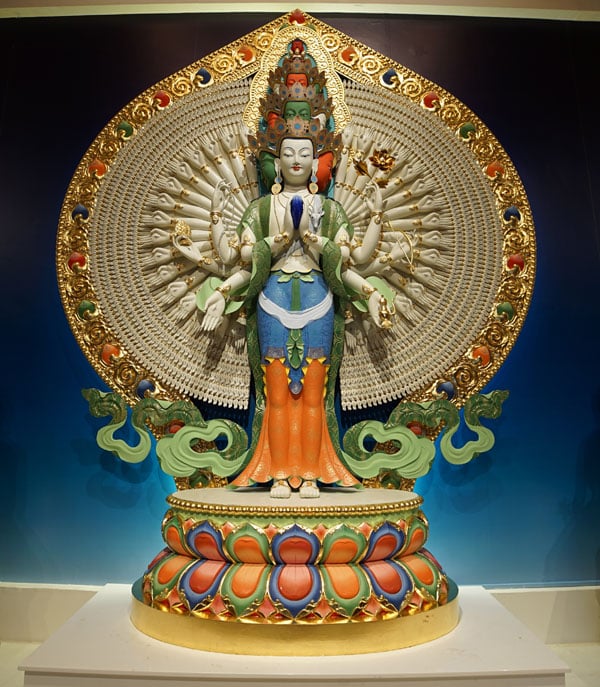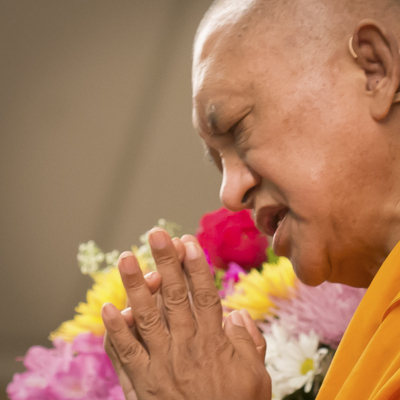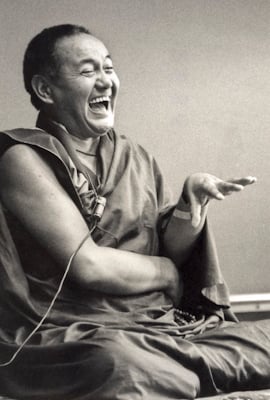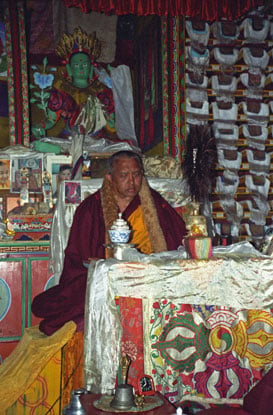Dear Friends,
Welcome to the March issue of our monthly e-letter, our 165th! We are overjoyed to bring you news of the various Dharma projects we are working on, as well as let you know about new content posted this month to our website and to all the other online portals we utilize to distribute these precious teachings to you.
And thank you so much to every one of you who contributed to make our Chotrul Duchen appeal so successful and we rejoice in our growing family of supporters who are partnering with us to make the Dharma wisdom of Lama Yeshe and Lama Zopa Rinpoche freely accessible to everyone, everywhere.
New From the LYWA video archive: Lama Yeshe on the Six Yogas of Naropa
Watch this incredible excerpt from extensive teachings on Lama Tsongkhapa's commentary on the Six Yogas of Naropa given by Lama Yeshe at Vajrapani Institute in California in 1983. In this excerpt Lama talks about the great mahasiddha Naropa and how his life shows us that intellectual study alone is not enough. We must go further and actually practice the teachings under the guidance of our guru. Lama later transmits the root text and advises a nonsectarian approach to these profound teachings.
You can read a lightly edited transcript of this teaching on our website. Lama's teachings on the Six Yogas of Naropa were published by Wisdom Publications in The Bliss of Inner Fire, which combines two commentaries Lama gave on this practice, this one at Vajrapani in 1983 and one at Istituto Lama Tzong Khapa in 1982-83.
FORTHCOMING by Lama Zopa Rinpoche: Abiding in the Retreat: A Nyung Nä Commentary.
 In her preface, editor Ven. Ailsa Cameron writes, “Compassion is the wish to free all living beings from suffering and its causes, and the embodiment of the compassion of all the buddhas is Chenrezig (Skt: Avalokiteshvara), the Buddha of Compassion. One of the most intensive and powerful Chenrezig practices is nyung nä, a two-day retreat that combines meditation on Thousand-Arm Chenrezig and recitation of Chenrezig’s mantra, OM MANI PADME HUM, with prostrations, fasting and silence. Abiding in the Retreat is a commentary to a nyung nä sadhana composed by Kelzang Gyatso, the Seventh Dalai Lama, according to the nyung nä lineage originating from Bhikshuni Lakshmi (Gelongma Pälmo), an Indian princess who cured herself of leprosy and achieved enlightenment through nyung nä practice.
In her preface, editor Ven. Ailsa Cameron writes, “Compassion is the wish to free all living beings from suffering and its causes, and the embodiment of the compassion of all the buddhas is Chenrezig (Skt: Avalokiteshvara), the Buddha of Compassion. One of the most intensive and powerful Chenrezig practices is nyung nä, a two-day retreat that combines meditation on Thousand-Arm Chenrezig and recitation of Chenrezig’s mantra, OM MANI PADME HUM, with prostrations, fasting and silence. Abiding in the Retreat is a commentary to a nyung nä sadhana composed by Kelzang Gyatso, the Seventh Dalai Lama, according to the nyung nä lineage originating from Bhikshuni Lakshmi (Gelongma Pälmo), an Indian princess who cured herself of leprosy and achieved enlightenment through nyung nä practice.
“Very little commentary to nyung nä practice is available in English. As nyung nä retreats are held each year in many FPMT centers, I thought to compile a nyung nä commentary by Lama Zopa Rinpoche, Spiritual Director of the FPMT,” Ven. Ailsa explains.
What does Rinpoche himself think about this practice? In the book, he says, “I want to inspire you, and I want to request you to do nyung näs. It’s such an incredible practice—so yum yum. To keep it very short, that’s the conclusion: yum yum!”
The book is in the final stages of editing and will go into production in early April. We will have copies by June! Watch this space. In the meantime, we've shared an excerpt from the book as this month's eletter teaching below.
New on the LYWA Podcast: Taking Care of the Mind
 Sometimes uncontrollable anger arises and uncontrollable self-cherishing thought arises, self-concern, anger, pride also, but then sometimes it makes you aware there’s choice. There’s choice. You can choose.
Sometimes uncontrollable anger arises and uncontrollable self-cherishing thought arises, self-concern, anger, pride also, but then sometimes it makes you aware there’s choice. There’s choice. You can choose.
Every month on the LYWA podcast we publish a different teaching from the Archive by Lama Yeshe or Lama Zopa Rinpoche. This month we hope you enjoy listening to this public talk by Lama Zopa Rinpoche on how taking care of our mind is the key to bringing peace and happiness to ourselves and to others. Rinpoche offered this talk at Conway Hall in London, England on July 10, 2014.
If you enjoy the podcast, please leave a comment on the podcast page! The more the people who leave a comment or review on the podcast, the greater our visibility in podcast directories like iTunes, Google Play, and more. Thank you!
The newly-redesigned LYWA podcast features incredible selections from the hundreds of hours of archival audio teaching by Lama Yeshe and Lama Zopa Rinpoche. All the podcasts provide links back to the full teaching from which they were drawn and you can also listen to the podcast while reading along with a lightly edited transcript.
What's New on our Website
 We have just posted a teaching from Lama Yeshe, Refuge is a State of Mind. Lama gave this address at a refuge ceremony held at Chenrezig Institute, Australia in September 1979. Edited by Nicholas Ribush. In this talk Lama explains what it means to take refuge, and engages in a questions-and-answer session with the students.
We have just posted a teaching from Lama Yeshe, Refuge is a State of Mind. Lama gave this address at a refuge ceremony held at Chenrezig Institute, Australia in September 1979. Edited by Nicholas Ribush. In this talk Lama explains what it means to take refuge, and engages in a questions-and-answer session with the students.
We are also happy to share a new translation of How to Practice Dharma into Russian by our Russian translator Anastasia Stoliarova. You can access a link to freely download a pdf of the book on our Russian translations page.
Our website continues to receive about 100,000 unique visitors each month, and we rejoice that so many people are finding the site helpful. More than half of our visitors view the site on a mobile device (a phone or tablet) and we have recently made many improvements to the mobile design, including menus, search features, and the overall layout. All of the features and content on our site can be viewed on a mobile device, so you can always access the teachings, audio, video and multimedia available from LYWA anywhere you are.
New Advice from lama zopa Rinpoche
Additions to Lama Zopa Rinpoche's Online Advice Book this month include:
The Prayer Wheel Brings Many Blessings: Advice for a student who had built a prayer wheel and sent Rinpoche a small video of it.
 The Power of the Holy Object: Rinpoche sent this letter to a student who was building some prayer wheels that Rinpoche had sponsored. The student was also building some stupas. Rinpoche reminds us that:
The Power of the Holy Object: Rinpoche sent this letter to a student who was building some prayer wheels that Rinpoche had sponsored. The student was also building some stupas. Rinpoche reminds us that:
Even the water from the rain or the wind touching the stupa and then touching insects or people has benefit—negative karma gets purified and people receive high rebirth. It plants the seed of enlightenment, making preparation for the mind to be liberated from the oceans of samsaric sufferings—all the sufferings we know and don’t know; and all the problems we don’t like. So there are infinite, infinite benefits from constructing stupas and prayer wheels correctly.
And for those working at Dharma centers:
Spending Money at the Center: Advice to a Dharma center about spending money to benefit others.
Lamrim and Lo-jong Are Best: How to act according to Dharma when someone working at the center forgets their practice.
As always, you can see a list of all newly-added advices to the Online Advice Book here.
e-Free Offering: Kadampa Teachings by Lama Zopa Rinpoche
 Look far ahead.
Look far ahead.
Generate a vast mind.
Don’t squeeze yourself.
It is wonderful to have a collection of Dharma titles on your mobile device to study whenever you have a moment. This month our free ebook offering is Lama Zopa Rinpoche’s Kadampa Teachings available from Smashwords in all formats including Kindle.
In Kadampa Teachings, Lama Zopa Rinpoche explains how we too can be like the great Kadampa geshes who inspire us with their intense dedication to the practice of thought transformation to develop the mind of bodhicitta. Rinpoche bases his teaching on Lama Atisha’s text The Bodhisattva’s Jewel Garland and inspires us as a perfect exemplar of these practices.
Thank you again for all your incredible support, which enables us to make all these amazing teachings freely available to everyone, everywhere.
Much love,
Nick Ribush
Director
This Month's Teaching: Don’t miss the opportunity
 Nyung nä is a practice that is very easy to do and yet has unbelievable power. There is extraordinary benefit in doing nyung näs. Everybody should definitely attempt to do nyung nä practice, this powerful method of purification. You shouldn’t regard nyung nä practice as unimportant and be careless about it. You must practice it, and from your heart you must recite OM MANI PADME HUM.
Nyung nä is a practice that is very easy to do and yet has unbelievable power. There is extraordinary benefit in doing nyung näs. Everybody should definitely attempt to do nyung nä practice, this powerful method of purification. You shouldn’t regard nyung nä practice as unimportant and be careless about it. You must practice it, and from your heart you must recite OM MANI PADME HUM.
Doing this practice is an unbelievably powerful way to collect the most extensive merit and to purify the negative karmas collected during beginningless rebirths. Doing that is a most powerful way to develop realizations, especially compassion for sentient beings. Doing Chenrezig meditation-recitation can really purify any negative karma and is the quickest way to achieve enlightenment. Don’t miss the opportunity to do this practice. And the harder you find it to do, the better it is, because you will purify more negative karma. As well as bringing powerful purification, however, it helps you to develop so much compassion for sentient beings.
Nyung nä practice is also very effective in healing sicknesses, even those that are difficult to cure, where other methods have been tried and haven’t helped. By confessing to the guru, reciting the Chenrezig mantra and doing nyung näs, people have been cured of such sicknesses. Nyung nä is very powerful.
If you do nyung nä practice and pray to Chenrezig, everything becomes easy. Because you purify any heavy negative karma you have collected in the past, it becomes easy for you to have realizations, to go to a pure land and to achieve enlightenment. It’s so easy to achieve enlightenment, without needing to undergo much hardship for many lifetimes or even eons. You don’t need to put in much effort. Just by doing prayers, and especially by reciting OM MANI PADME HUM, there’s no doubt that you will be able to go to a pure land.
If you make a request to Chenrezig one time, Chenrezig will then guide you in all your future lives. So there’s no doubt that this will happen if you make requests to Chenrezig every day. By doing Chenrezig practice, you don’t have to be reborn again and again in a suffering world and experience problems again and again. It makes it so easy to be born in a pure land and to finish all the problems of life; you won’t have to experience problems again.
With Chenrezig as your special deity, if you make prayers to Chenrezig, your life becomes so easy. You accomplish whatever you want to do, whether reflecting or meditating, without much difficulty or great effort. Without doubt, if you make prayers to be born in a pure land, just with the mere prayer you will be able to be born in a pure land.
In essence, we are most fortunate beings, having the opportunity to chant OM MANI PADME HUM, meditate on Chenrezig and do nyung näs. It’s so easy for us to achieve enlightenment. We don’t need to collect merit for many eons; we can complete all those merits within one life, in the brief lifetime of a degenerate time. So, we must take the opportunity to recite the Compassion Buddha’s mantra, OM MANI PADME HUM, as much as we can every day, and also to do as many nyung näs as possible. Our aim is to develop great compassion for sentient beings. Our main project should be to develop bodhicitta in this life. Since we need the blessing of Chenrezig for that, we need to do as much Chenrezig practice as possible.
If you can, it would be good to do one hundred nyung näs, especially at one time in a retreat of one hundred nyung näs or more, even a thousand. Of course, more is always better. Tenzin Namdrol, a Brazilian nun, has finished more than five hundred nyung näs, and is continuing nyung nä practice as she has accepted my request to do one thousand nyung näs. There are a few FPMT students who have completed more than one hundred nyung näs, including Ailsa [Cameron], who leads nyung näs quite often at Chenrezig Institute, where they have been doing eight nyung näs as a group at Saka Dawa for many years. But it’s best to finish the one hundred nyung näs within one year, I think. In the future, it could be done like that.
I think everybody should do at least one nyung nä each year. But if you can do more, that’s very, very good as a nyung nä contains many preliminary practices. By doing nyung näs, you become a sincere, good-hearted practitioner. Since it’s an intense practice, it’s very helpful for realizations. Realizations come when we purify our defilements; otherwise, realizations don’t happen. The more we purify, the more realizations come. It’s like with a mirror: the more dust you clean from the mirror, the more reflections come in the mirror. Our mind is like a mirror. As we clean the mirror of our mind, it’s able to give more and clearer reflections. Like that, realizations, including enlightenment, come.
It’s also very good to learn how to lead a nyung nä well. I think that’s a very important way to help others; many people can then learn from you.
I want to inspire you, and I want to request you to do nyung näs. It’s such an incredible practice—so yum yum. To keep it very short, that’s the conclusion: yum yum!
Excerpted from Lama Zopa Rinpoche, Abiding in the Retreat: A Nyung Nä Commentary. Edited by Ailsa Cameron. Forthcoming from LYWA this year.





























